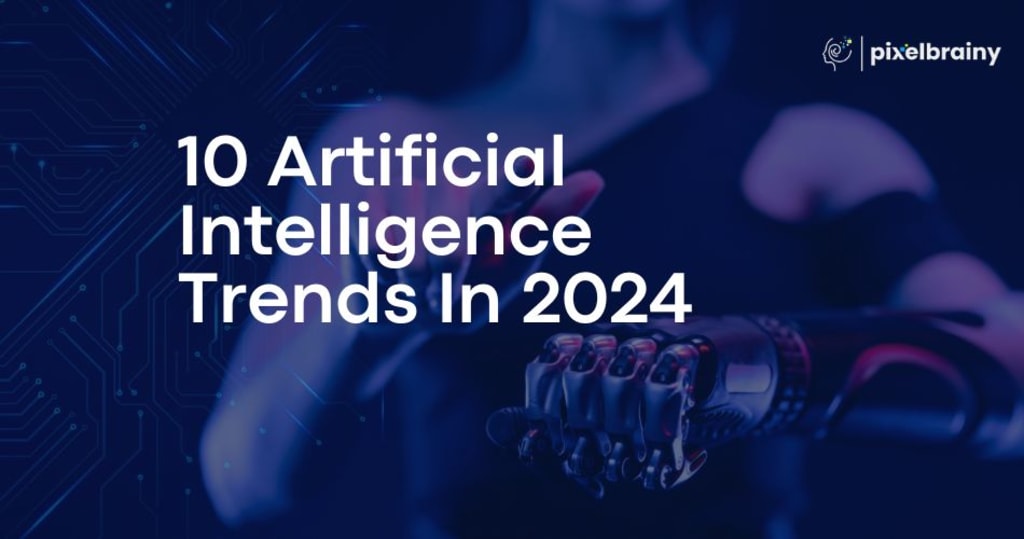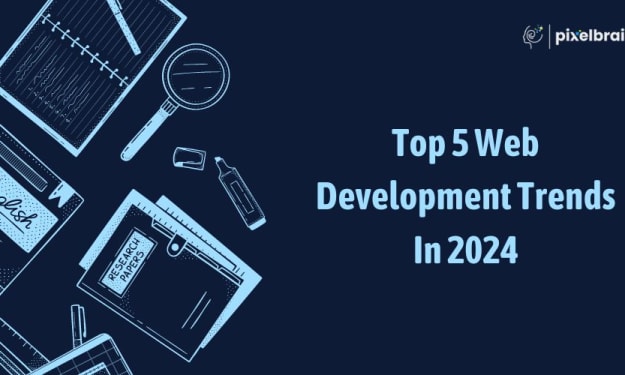10 Artificial Intelligence Trends In 2024
10 Artificial Intelligence Trends In 2024: Shaping the Future of Innovation and Industry

Artificial intelligence (AI) has been a major focus in the tech industry for years, and its momentum is only increasing. As we approach 2024, several key AI trends are poised to shape the industry and significantly impact businesses and consumers. This blog post will delve into 10 prominent AI trends expected to dominate the landscape in 2024, from ethical considerations and advancements in natural language processing to the rise of edge AI and personalized experiences. Understanding these trends will be crucial for businesses and organizations aiming to harness AI's potential and stay competitive in an increasingly AI-driven world.
10 AI Trends In 2024
1. Continued Growth in AI Adoption
AI technologies are increasingly being integrated across various industries to enhance operational efficiency, reduce costs, and foster innovation.
Examples:
• Retail: Amazon uses AI for inventory management, dynamic pricing, and personalized recommendations, significantly boosting sales and customer satisfaction.
• Finance: Banks like JPMorgan Chase employ AI for fraud detection and to provide personalized financial advice, improving security and customer service.
2. Ethical AI
There is a growing focus on ensuring that AI systems are fair, transparent, and respect human rights. Ethical AI aims to mitigate biases and ensure the responsible use of AI technologies.
Examples:
• IBM’s AI Fairness 360: A comprehensive toolkit to help developers detect and mitigate bias in machine learning models.
• Microsoft’s Responsible AI Standard: Guidelines to ensure AI development aligns with ethical principles and regulatory standards.
3. AI-Powered Automation
AI-driven automation is transforming various sectors by automating repetitive tasks and enabling more complex processes to be handled efficiently.
Examples:
• Manufacturing: General Electric uses AI for predictive maintenance, reducing downtime and extending the lifespan of machinery.
• Customer Service: Chatbots and virtual assistants, like those used by companies such as Sephora and H&M, handle customer inquiries, allowing human agents to focus on more complex issues.
4. Advancements in Natural Language Processing (NLP)
NLP advancements are making it possible for AI to better understand and interact with human language, enhancing communication capabilities.
Examples:
• OpenAI’s GPT-4: Used in applications like ChatGPT, it powers sophisticated conversational AI, enabling more natural and meaningful interactions.
• Google’s BERT: Improves search engine accuracy by better understanding the context of user queries.
5. AI in Healthcare
AI technologies are revolutionizing healthcare by enhancing diagnostic accuracy, personalizing treatment plans, and streamlining administrative tasks.
Examples:
• IBM Watson Health: Utilized for cancer treatment planning, providing doctors with data-driven insights to develop personalized care plans.
• PathAI: Uses AI to improve pathology diagnoses, increasing accuracy and efficiency in identifying diseases.
6. Edge AI
Edge AI processes data locally on devices rather than relying on centralized cloud servers, enabling real-time data analysis and decision-making.
Examples:
• Autonomous Vehicles: Tesla’s self-driving cars use edge AI to process data from sensors in real-time, allowing for immediate responses to road conditions.
• IoT Devices: Smart home devices like Amazon Echo use edge AI for faster response times and enhanced user experience.
7. AI for Cybersecurity
AI-driven cybersecurity solutions are becoming essential to proactively detect and mitigate complex cyber threats in real time.
Examples:
• Darktrace: Utilizes AI to identify unusual patterns and detect potential cyber threats, allowing for immediate countermeasures.
• Symantec’s AI Solutions: Offer advanced threat detection and response capabilities, protecting businesses from sophisticated attacks.
8. Personalized AI Experiences
AI enables highly personalized experiences by leveraging vast amounts of data to tailor services and recommendations to individual users.
Examples:
• Netflix: Uses AI to analyze viewing habits and provide personalized content recommendations, enhancing user engagement.
• Spotify: Employs AI to curate personalized playlists and discover weekly suggestions based on user listening history.
9. Responsible AI Governance
Establishing frameworks for responsible AI governance ensures that AI development and deployment align with ethical standards and regulatory requirements.
Examples:
• European Union’s AI Act: Aims to create a legal framework to ensure that AI systems are safe and respect fundamental rights.
• Google’s AI Principles: Guidelines to ensure the responsible development and deployment of AI technologies.
10. Collaboration Between Humans and AI
AI is increasingly being used to augment human capabilities, allowing humans and AI to work together to achieve better outcomes.
Examples:
• Medical Diagnosis: AI systems assist radiologists in interpreting medical images, increasing accuracy and allowing doctors to focus on patient care.
• Creative Industries: AI tools like Adobe Sensei help artists and designers by automating routine tasks and providing creative suggestions, enhancing the creative process.
Conclusion
In conclusion, the year 2024 is poised to be an exciting time for the field of artificial intelligence, with significant advancements and widespread adoption across industries. From ethical considerations to technological advancements, the trends outlined above are set to shape the future of AI and drive innovation in the years to come. As businesses and organizations continue to harness the power of AI, it will be crucial to stay abreast of these trends and adapt strategies accordingly to remain competitive in an increasingly AI-driven world. Partnering with an AI development company can provide the expertise and resources needed to effectively implement these AI trends and leverage their full potential.
About the Creator
Sagar Bhatnagar
Sagar Sahay Bhatnagar is the Co-founder and CTO at PixelBrainy, bringing over a decade of experience in the IT industry. A visionary tech leader, Sagar excels in innovative software development and strategic technology management.
Enjoyed the story? Support the Creator.
Subscribe for free to receive all their stories in your feed. You could also pledge your support or give them a one-off tip, letting them know you appreciate their work.






Comments
There are no comments for this story
Be the first to respond and start the conversation.